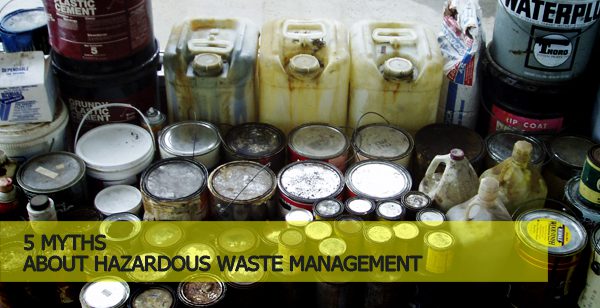
Hazardous Waste Management should never be taken lightly. It is extremely important to address the different types of disposal, recycling and handling, as well as the transportation interaction with care and concern. Over time, waste can become increasingly reactive. Not every business has qualified environmental health and safety personnel on staff. In that case it becomes necessary to find a qualified hazardous waste vendor to answer any questions you may have. There are many common misconceptions regarding hazardous or non-hazardous wastes, we are going to look at and discuss the top 5 myths.
1. “A product is labeled as non-hazardous so I can just throw it in the trash, right?”
Many facilities use non-hazardous ingredients in the formulas of their products, however ALL wastes must be evaluated prior to disposing of them. Depending on which disposal facility is used, they occasionally classify business wastes as industrial waste which could mean more stringent state or federal regulations.
2. “If I send my waste as a non-hazardous industrial waste, I don’t need a paper trail to show proper disposal.”
All hazardous and non-hazardous waste are required to have cradle-to-grave tracking. It is always good to verify this with your disposal and recycling vendors before shipping waste off site. Occasionally there can be additional fees for this type of paperwork, however a vendor that has a good reputation should be able to provide you with this service at no cost and without asking.
3. “Signing a hazardous waste manifest for my employer’s waste does not mean that I need DOT Hazardous Material training.”
Any individual that is involved with the shipment and recycling of hazardous or non-hazardous waste is required to have DOT Title 49 CFR (172.704) hazardous material training every 3 years. The training covers areas such as packaging, labeling, loading, paperwork preparation and handling.
4. “Once I have released my hazardous waste to a recycling facility, I am no longer responsible for it.”
Much like the previous paper trail myth, all generators have cradle-to-grave responsibilities when it comes to their waste. According to the CERCLA legislation, even after you have officially paid for the proper disposal of waste, you are liable for potential cleanup until it is officially destroyed or recycled. Read more at the EPA website about CERCLA and superfund sites to better understand your potential liability for mishandled wastes.
5. “If I have old paint, I can just pour it on some paper until it dries and then just throw it out right?”
In many states it is forbidden to dry oil based (flammable) paints and then throw them into the trash. Sometimes it is possible to dry Latex (water based paint) however the waste could be considered an industrial waste and therefore regulated by your state. With paints or other questionable waste it is highly recommended that the most responsible waste disposal and recycling practices are used in order to decrease the amount of exposure and current / future liability.
